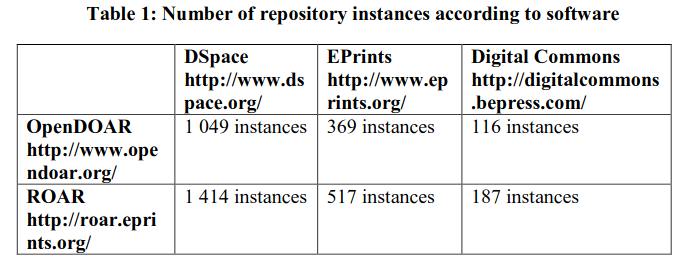1.3 Open Source Repository Software
According to the Budapest Open Access Initiative14planning the implementation of an institutional repository entails policy, legal, educational, cultural, and technical components, most of which are interrelated and each of which must be satisfactorily addressed for the repository to succeed. Selecting a software system that best satisfies the needs of an institution is just one facet of institutional repository implementation planning. In the next session types of repository software will be discussed, as well as the criteria according to which repository software can be evaluated.
1.3.1 Repository software
There are mainly two different categories of repository software:
- Open Source software, e.g. DSpace, Fedora, EPrints; and
- Hosted solutions, e.g. Digital Commons, SimpleDL, ContentDM, DSpaceDirect.
As indicated previously, open source software (OSS) is synonymous with Open Access. OSS offers many benefits, incl.:
- It promotes collaboration and knowledge sharing amongst communities;
- All participants benefit, and not only the vendor;
- The product belongs to all and lots of support is available from the OSS community;
- No marketing is involved, therefore there is no salesman involved selling the product only focusing on the positive features, and not the limitations;
- With OSS what you see is what you get;
- OSS is flexible, its source code is open, and can be customized to be interoperable with other software at an institution; It is open for scrutiny, and can be installed and tested before taking a final decision;
- It can be implemented by institutions with minimal resources; and
- World standards and open standards are used, which makes it a favorable choice.
1.3.2 Criteria for the evaluation of an institutional repository
Software is continuously upgraded and enhanced, and new functionalities are added to meet the needs of the user community. A decision to use a specific software system/platform can be based on a literature survey, or based on an evaluation following the installation of the various software systems on a test server. This will depend on the expertise and capacity within an institution. When making a decision on which software to use, the needs of the user community should be matched with the functionality of the software. Although different communities might have different needs, the following criteria from the Open Society Institute15(2004) can be used as a guideline when conducting an evaluation of available software:
- Technical specifications
- Repository and system administration
- Content management
- Dissemination
- Archiving
- System maintenance
Fay16 (2010) compared three repository software systems based on five functional areas. The three systems were Fedora, Eprints and DSpace. The functional areas evaluated include:
- Data model: What kinds of digital objects can be submitted? Will configuration be required?
- Ingest, Data: Does it support flexible human- and machine-ingest? Does the functionality exist to conduct digital object management and administration operations? Can workflows be customized?
- Descriptive Information (Metadata): Does system support extensible metadata schemas, also for descriptive, technical, preservation and format-specific metadata? Is the metadata OAI-PMH compliant? Are independent, persistent and human-readable identifiers assigned?
- Storage: Are digital objects stored independent of the repository, which is preferred for preservation purposes?
- Access: Does the system come with an out-of-the box interface? Is access to content at granular level controlled? Which authentication system/s is used?
Castagné17 (2013) conducted and reported on a more recent environmental scan of DSpace, EPrints, Digital Commons and Fedora Commons. These packages were selected based on their ROAR statistics and overall suitability for a large research library. Installation/administration processes (incl. metadata, interoperability), content management (incl. embargoes, versioning, preservation, statistics, file formats, batch importing, user interface, search) and support were evaluated. There is no such thing as a perfect system, and the choice will all depend on the available institutional resources in the end. Although not the ideal, it would be possible to migrate from one system to anothershould it become necessary, since open standards are used and open source systems (OSS) are compatible with one another. The following table gives an indication of the popularity of repository software systems (November 2013):

1.3.3 Comparison of repository software
Depending on the needs analysis, an evaluation checklist with criteria can be compiled to evaluate available software that will best address the needs of a specific user community. Various studies have been conducted on available software and functionalities, e.g. London School of Economics and Political Science (2010), University of York (2008), Castagné (2013) Open Society Institute (2004), and the Repositories Support Project18 (2010). Because technology rapidly develops, the studies conducted only provide a guideline. For the most recent specifications on the various systems, the web pages for the individual systems should be visited. The decision to use a specific system can be based on a literature survey only, or based on results of an evaluation after the software has been installed within a test environment. If it is not possible to install the software, the demo versions can be accessed and tested online. The Repositories Support Project (RSP), a 7 year JISC-funded initiative contributing to building repository capacity, knowledge and skills within UK higher education institutions released a detailed study of comparison of repository software19. We suggest you to download and review the list20. Recently UNESCO also released a study comparing institutional repository software. The comparison is divided into twelve categories to help librarians identify the features that are most important to building a successful institutional repository program at their institution. The criteria include: infrastructure, front-end design, content organization and control, content discovery, publication tools, reporting, multimedia, social features and notification, interoperability, authentication, accessibility, and preservation. The study21 covered five software: Digital Commons, DSpace, Fedora, EPrint, and Islandora.
